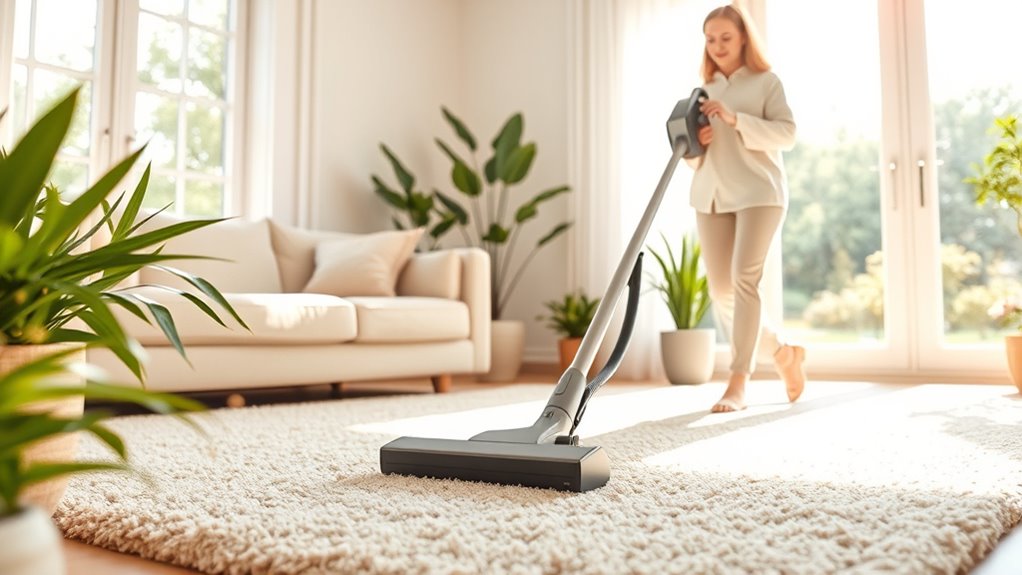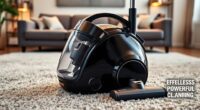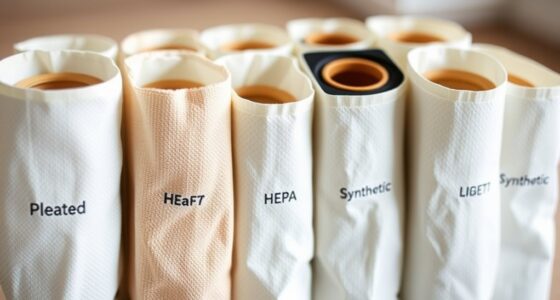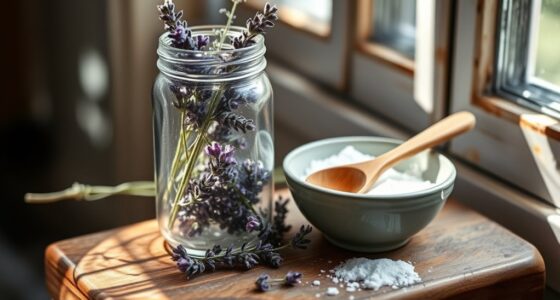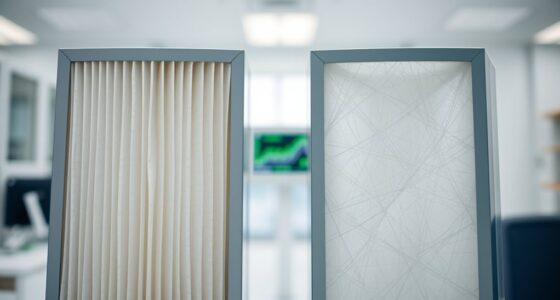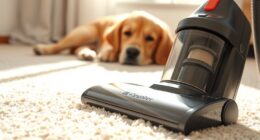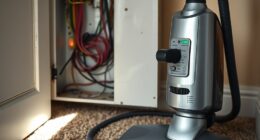During pollen season, you can prep your home effectively by vacuuming regularly with a HEPA filter vacuum to trap tiny allergen particles. Focus on carpets, upholstery, and hard-to-reach spots, using proper techniques like slow, overlapping passes. Combine this with air purifiers for added allergen removal and keep windows closed during peak periods. With these expert tips, you’ll reduce indoor pollen and breathe easier—discover more ways to boost your allergy-proofing skills as you go.
Key Takeaways
- Use a HEPA-filter vacuum regularly on high-traffic areas, carpets, and upholstery to trap pollen and dust mites effectively.
- Vacuum slowly with overlapping passes and reach under furniture and along baseboards for thorough allergen removal.
- Combine vacuuming with air purifiers equipped with HEPA filters to capture airborne pollen stirred during cleaning.
- Keep windows closed during peak pollen season and use proper ventilation when outdoor pollen levels are low.
- Maintain your vacuum and air purifier filters regularly to ensure ongoing allergen control and indoor air quality.
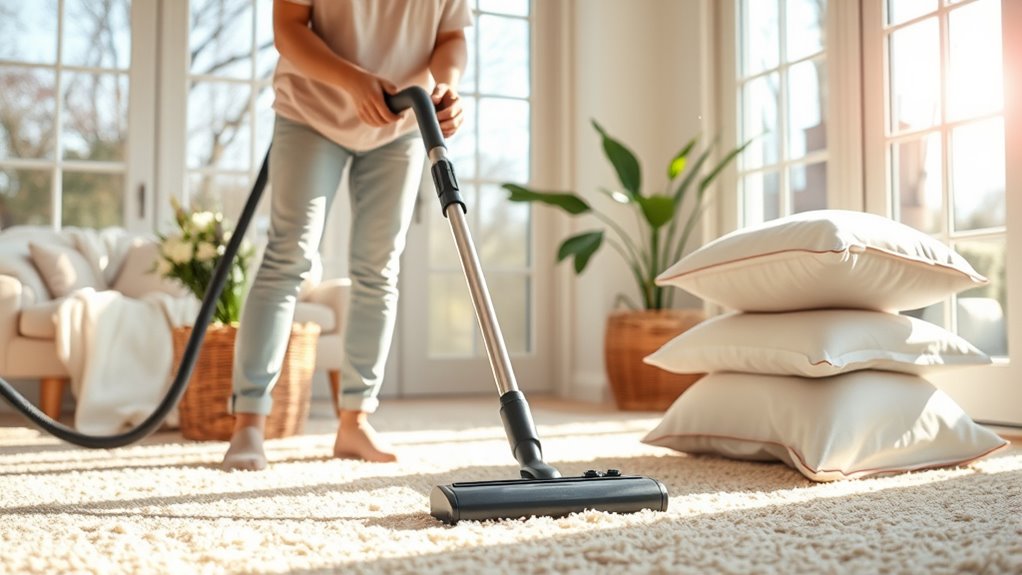
As pollen counts rise during allergy season, regular vacuuming becomes vital for reducing indoor allergens. You want to keep your home as allergen-free as possible, and understanding how your vacuum cleaner works can make a big difference. The effectiveness of your air purifier also plays an essential role in maintaining a healthy environment. Combining allergy friendly vacuuming techniques with a good air purifier can considerably cut down on airborne pollen and dust mites, which are common triggers during this time of year.
When it comes to vacuuming, not all machines are created equal. To maximize air purifier effectiveness, you should opt for a vacuum with a HEPA filter. These filters trap tiny particles, including pollen, pet dander, and dust mites, preventing them from recirculating into the air. Regularly cleaning or replacing your vacuum’s filter ensures it maintains peak performance. Additionally, using a vacuum with strong suction and a sealed system helps contain allergens inside the machine rather than releasing them back into your home. This is a cornerstone of allergy friendly vacuuming, which aims to minimize allergen distribution during cleaning sessions.
Choose HEPA-filter vacuums with strong suction and sealed systems for optimal allergen containment.
You also want to pay attention to your vacuuming technique. It’s best to vacuum high-traffic areas and places where dust and pollen tend to settle most often—like carpets, rugs, upholstery, and curtains—at least twice a week. Use slow, overlapping passes to ensure thorough removal of allergens embedded deep within fibers. Don’t forget to vacuum under furniture and along baseboards, as these spots often harbor hidden pollen and dust. For added efficiency, consider using a vacuum with a crevice tool or upholstery attachment, which helps target difficult-to-reach areas that can trap allergens. To further improve indoor air quality, consider the role of air purifier technologies in capturing airborne particles stirred up during vacuuming. Proper ventilation, such as opening windows when pollen counts are low, also assists in diluting indoor allergens. However, during peak pollen season, keeping windows closed and relying on air purifiers can prevent outdoor pollen from entering your home.
Frequently Asked Questions
How Often Should I Replace My Vacuum Filter During Pollen Season?
You should replace your vacuum filter every 1 to 3 months during pollen season to guarantee ideal filter maintenance. Regularly changing the filter helps maintain your vacuum’s lifespan and keeps allergens out of the air. If you notice a decline in suction or increased dust, it’s time for a replacement. Proper filter maintenance not only improves cleaning efficiency but also protects your indoor air quality during peak pollen times.
Can Vacuuming Help Reduce Pollen Allergies Indoors Effectively?
Vacuuming can substantially reduce indoor pollen, helping you breathe easier. It’s an effective allergy-friendly cleaning method that removes pollen from carpets and upholstery. Coupled with an air purifier benefits, your home becomes a healthier environment. Regular vacuuming, especially with a HEPA filter, minimizes pollen buildup and allergens. This proactive approach helps you manage allergy symptoms better and creates a cleaner, more comfortable space during pollen season.
What Type of Vacuum Cleaner Is Best for Pollen Removal?
Is your home a battleground for pollen? Choose an upright vacuum with a HEPA filter to win the fight. These vacuums trap tiny allergens, preventing them from escaping back into the air. An upright model offers powerful suction for deep cleaning, making it easier to remove pollen from carpets and floors. With a HEPA filter, you can breathe easier, knowing you’re effectively reducing indoor pollen levels and allergy symptoms.
Should I Vacuum All Surfaces or Focus on Certain Areas?
You should focus on key areas when vacuuming during pollen season. Use effective vacuuming techniques by targeting high-traffic spots, upholstery, and curtains, which trap pollen. Instead of trying to vacuum all surfaces equally, prioritize surface cleaning strategies that remove pollen buildup. Pay special attention to carpets and bedding, as these harbor the most allergens. This targeted approach helps reduce pollen indoors and improves your home’s air quality efficiently.
How Can I Prevent Pollen From Entering My Home in the First Place?
To prevent pollen from entering your home, start by sealing windows tightly and installing airlock entryways to reduce outdoor air infiltration. Keep windows closed during pollen season, and use high-efficiency filters in your HVAC system. You can also place doormats and encourage handwashing before entering. These steps help create a barrier, minimizing pollen entry and keeping your indoor air cleaner.
Conclusion
As pollen season unfolds, a gentle touch with your vacuum becomes a quiet act of care, creating a sanctuary within your home. Embrace these small routines as a refined way to nurture your space, allowing you to breathe easier and enjoy the season’s beauty without distraction. With each deliberate pass, you’re subtly elevating your environment, turning everyday chores into a graceful dance of preservation. In this quiet effort, you craft a haven of comfort and serenity.
